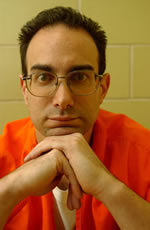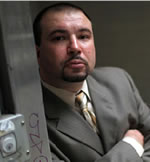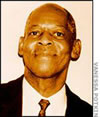Marty Tankleff
Marty Tankleff had just turned 17 when he was arrested for killing his parents, Seymour and Arlene Tankleff, in their home on Long Island, New York. Based on a dubious, unsigned “confession” extracted from him following hours of interrogation by a detective with a questionable background, Marty was convicted and sentenced to 50 years to life, and served close to 18 years in maximum security prisons for a crime he did not commit.
SUFFOLK COUNTY JUSTICE
 September 7, 1988: A Long Island Teenager Discovers His Parents Stabbed and Bludgeoned
September 7, 1988: A Long Island Teenager Discovers His Parents Stabbed and Bludgeoned
Marty Tankleff woke up on the first day of his senior year in high school to discover his mother and father brutally stabbed and bludgeoned, his mother, Arlene Tankleff dead, his father – Seymour Tankleff – unconscious but alive. Marty called 911 and gave first-aid to his father.
The Lead Detective Ignores the Obvious Suspect and Interrogates Marty
When the police arrived, Marty immediately identified the likely suspect: his father’s bagel-store partner, who owed his father half a million dollars, had recently violently threatened his parents, and who was the last guest to leave the Tankleff home the night before. A week after the attacks, as Marty’s father lay unconscious in the hospital, the business partner would fake his own death, disguise himself and flee to California under an alias. Despite the business partner’s motive and opportunity, he has never been considered a suspect by Suffolk County authorities to this day. Instead, the lead detective immediately took Marty to the police station and began a hostile interrogation of him that would last for hours.
A Culture of Corruption in Suffolk County Law Enforcement
At the time of the Tankleff murders, Suffolk County law enforcement was under investigation for corruption”including problems with coerced confessions” by the State Investigation Commission (SIC) on the order of Governor Mario Cuomo. The SIC’s scathing report included a finding that the detective who would interrogate Marty had perjured himself in a previous murder case.
The Detective Lies and a Traumatized, Disoriented
Teenager Confesses
The hostile interrogation was no match. Marty had been brought up to trust the police and the word of his father, so when the detective faked a phone call and lied to Marty that his father had come to and identified him as the killer, Marty was led to wonder if he could have blacked out. Only then did the detective read Marty his rights and draft a “confession,” which was unsigned and immediately recanted by Marty. Marty’s father died weeks later, without having regained consciousness.
Marty is Convicted and Sentenced to 50-Years-to-Life
Even today, with DNA testing having proven that a quarter of wrongful convictions were based on false confessions, intelligent and educated people have difficulty accepting the counterintuitive proposition that someone would confess to a murder they didn’t commit. In 1990, despite not one shred of physical evidence linking Marty to the crime, his confession was enough to get him convicted and sentenced to 50-years-to-life.
II: MARTY KEEPS THE FAITH
A Private Investigator Finds New Evidence
With the support of two dozen relatives, including the sisters and brother of the murder victims and with a devoted team of lawyers, an investigator and advocates working pro bono, Marty worked ceaselessly to regain his freedom. In 2001, he convinced a retired New York City homicide detective to conduct a reinvestigation into the case. All leads led back to the business partner, whose son, it turns out, sold cocaine out of the bagel stores. The son’s enforcer had bragged over the years about having participated in the Tankleff murders. Through the drug enforcers arrest records, the investigator found an accomplice who admitted to having been the getaway driver on the night of the murders.
The New Evidence Hearing
Based on the getaway driver’s affidavit and other corroborating new evidence, Marty’s lawyers filed a motion for a new trial, which led to months of evidentiary hearings in a Suffolk County courtroom. As a result of media coverage and further investigation by Marty’s defense team, many new witnesses came forward. By the end of the hearing, over two dozen witnesses would present overwhelming evidence of Marty’s innocence and others guilt.
Conflict. Cover-up. Conflict. Conspiracy?
The Suffolk County DA refused to recuse himself from the hearing despite extreme conflicts of interest. Five years before the Tankleff murders, he had represented the business partner’s son for selling cocaine out of the bagel store. During the SIC hearings, he represented the detective who would go on to take Marty’s confession. And his longtime partner had represented the business partner himself. Among the new evidence revealed at the hearing was eyewitness testimony that the business partner had been well acquainted with the lead detective since before the Tankleff murders. This contradicted the trial testimony of the detective, who had not been in line to catch the case on the morning of the Tankleff murders but arrived 19 minutes after the early morning call, and who ignored the business partner as a suspect.
Out of Suffolk County
Throughout the hearing, the DA used every tactic at his disposal, including witness intimidation, to discredit the new evidence and protect the conviction. The Suffolk County judge presiding over the hearing ruled in favor of the DA on every motion, and on St. Patrick’s Day of 2006 denied Marty’s motion for a new trial.
III: THE TRUTH SETS MARTY FREE
The Appeal
Marty appealed his case to the Appellate Division of the Supreme Court of the State of New York in Brooklyn. In a sign of the extraordinary support the case has received, several high profile organizations and individuals submitted amicus briefs, including 31 former prosecutors, Barry Scheck and the Innocence Project, The National Association of Criminal Defense Lawyers, and more.
Millions around the world have seen Marty’s story on CBS News’ 48 Hours and other shows. Thousands of outraged citizens from Suffolk County, New York State, across the United States and as far away as Australia have visited MartyTankleff.org to voice their support and sign a petition calling on the governor and attorney general to appoint a special prosecutor.
Indeed, every impartial observer who has reviewed Marty case, including retired judges, law professors, investigative journalists and court officers agree that Marty deserves a new trial.
Marty’s conviction is Vacated
On December 21, 2007, the Appellate Court, Second Department, vacated Marty’s conviction and ordered his case back to Suffolk County for a retrial “to be conducted with all convenient speed.”
“It is abhorrent to our sense of justice and fair play to countenance the possibility that someone innocent of a crime may be incarcerated or otherwise punished for a crime which he or she did not commit,” the ruling stated.
New York State Investigation Commission Announces Probe into Suffolk County Law Enforcement’s Conduct in the Tankleff Case Over the Past Two Decades
On December 28, 2007, The New York Times broke the news that the New York State Investigation Commission (SIC) has begun an official investigation into Suffolk County law enforcement’s handling of the Tankleff case. The Times reports the investigation began quietly over a year ago, but was kept quiet until now so as not to interfere with Marty’s legal appeal.The S.I.C. is viewing this as a serious and significant investigation. The commission is looking at how Suffolk County handled this case, said the Times’s source.
Governor Appoints Attorney General Cuomo as Special Prosecutor
On January 12, 2008, Gov. Eliot Spitzer appointed Attorney General Andrew Cuomo as special prosecutor in the Tankleff case. Cuomo pledges to “follow the evidence wherever it leads us.
Attorney General Cuomo Moves to Dismiss all Charges
On June 30, 2008, Attorney General Cuomo’s office announced it would not retry Marty, citing insufficient evidence to prove his guilt.
All Charges Dismissed
On July 22, 2008, a a State Supreme Court Justice dismissed all charges against Marty Tankleff in the murder of his parents, Arlene and Seymour Tankleff.




 September 7, 1988: A Long Island Teenager Discovers His Parents Stabbed and Bludgeoned
September 7, 1988: A Long Island Teenager Discovers His Parents Stabbed and Bludgeoned